
Pieter Cramer, was a wealthy Dutch merchant in linen and Spanish wool, remembered as an entomologist. Cramer was the director of the Zealand Society, a scientific society located in Flushing, and a member of Concordia et Libertate, based in Amsterdam. This literary and patriotic society, where Cramer gave lectures on minerals, commissioned and/or financed the publishing of his book De uitlandsche Kapellen, on foreign (exotic) butterflies, occurring in three parts of the world Asia, Africa and America.
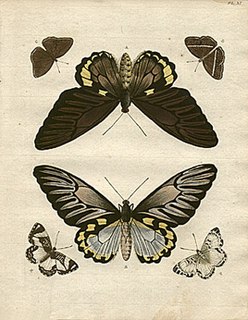
Caspar Stoll was a naturalist and entomologist, best known for the completion of De Uitlandsche Kapellen, a work on butterflies begun by Pieter Cramer. He also published several works of his own on other insect groups. Stoll's 1787 publication on stick insects, mantids and their relatives is also well known. It was translated into French in 1813.

Banksia splendida, commonly known as shaggy dryandra, is a species of shrub that is endemic to the southwest of Western Australia. It has sharply-pointed linear leaves that are woolly on the lower surface, cream-coloured and maroon or yellow flowers in heads of between 65 and 115, and later up to eight egg-shaped follicles in each head.
Banksia splendida subsp. splendida is a subspecies of Banksia splendida. It was known as Dryandra speciosa subsp. speciosa until 2007, when Austin Mast and Kevin Thiele sunk all Dryandra into Banksia. Since the name Banksia speciosa had already been used, Mast and Thiele had to choose a new specific epithet for D. speciosa and hence for this subspecies of it. As with other members of Banksia ser. Dryandra, it is endemic to the South West Botanical Province of Western Australia. As an autonym, it is defined as encompassing the type material of the species.

Cucullia is a genus of moths of the family Noctuidae.
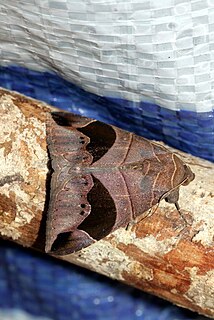
Bastilla joviana is a moth of the family Noctuidae first described by Stoll in 1782. It is found from the Oriental region to the Moluccas and in New Guinea and Australia. It is also present in South Africa.
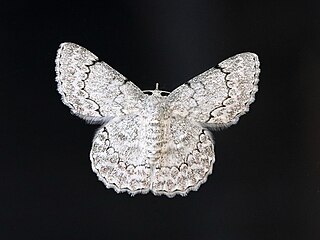
Pingasa chlora, the white looper moth or flower-eating caterpillar, is a species of moth of the family Geometridae first described by Caspar Stoll in 1782. It is found Sundaland, the Philippines, Sulawesi and from the Moluccas to Queensland, Australia.

Lymantria lunata, the luna gypsy moth, is a moth of the family Erebidae. The species was first described by Caspar Stoll in 1782. It is found in Southeast Asia, from India to the northeast coast of Australia.

Euriphene is a butterfly genus in the subfamily Limenitidinae. The 70 or so member species are confined to the Afrotropical realm. They are found mainly in the Guinean Forests of West Africa and the Congolian forests.
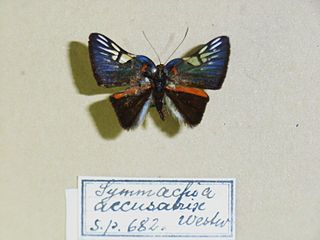
Symmachia is a genus in the butterfly family Riodinidae present only in the Neotropical realm.
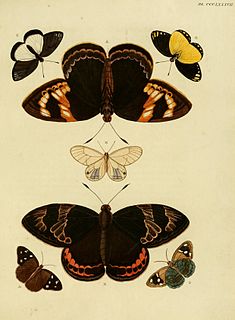
Delias dorimene is a butterfly in the family Pieridae. It was described by Caspar Stoll in 1782. It is found in the Australasian realm.
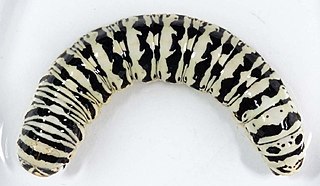
Cucullia speyeri, common names Speyer's paint, Speyer's cucullia or Speyer's hooded owlet moth, is a moth found in North America. It is found from Alberta and Montana to the Atlantic coast from New Hampshire to Virginia. It was described by Joseph Albert Lintner in 1874. In the US state of Connecticut, it is listed as a species of special concern and is believed to be extirpated. The habitat consists of open meadows, dry grasslands and native prairies.
Cucullia omissa, known generally as the omitted cucullia or Alberta falconer, is a species of moth in the family Noctuidae. It is found in North America.
Cucullia laetifica is a species of moth in the family Noctuidae. It is found in North America.
Cucullia alfarata, the camphorweed cucullia, is a species of moth in the family Noctuidae. It is found in North America.
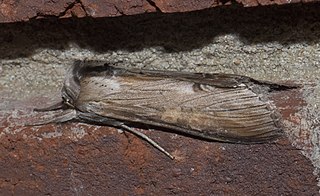
Cucullia asteroides, known generally as the goldenrod hooded owlet or asteroid moth, is a species of moth in the family Noctuidae. It is found in North America.












